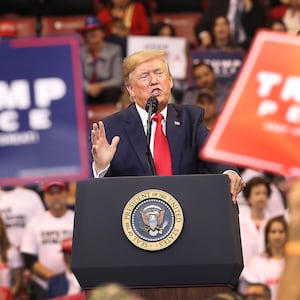President Trump’s critics have never lacked for legitimate complaints. His unpresidential behavior has included dishonesty, personal attacks, a petty lack of loyalty, and a Twitter feed that makes most Americans cringe. On the international front, he has cozied up to dictators, insulted allies, and abandoned trade agreements.
Trump also had his share of domestic policy failures: soaring budget deficits, runaway spending, tariffs, an immigration crisis at the border, and the lack of a fully-formed health plan to expand access and reduce costs. The president’s inconsistent downplaying of the coronavirus pandemic did not inspire confidence either.
However, we should avoid the knee-jerk partisanship of entirely dismissing Trump’s domestic policy record. There have also been successes that can inform future lawmakers and presidents.
When Trump took office in January 2017, the United States economy was in the eighth year of an expansion—the point at which a full-employment economy typically reaches its full capacity and begins to shift downward towards recession. Indeed, much of the 2017 and 2018 economic narrative centered around managing a soft landing and avoiding a deeper recession.
Along those lines, the Congressional Budget Office (CBO) projected in early 2017 that the unemployment rate would level off around 4.5 percent before turning upward. Instead, through the onset of the pandemic, the economy created 6.6 million net jobs—nearly twice as many as CBO had forecast—reducing the unemployment rate to a 50-year low of 3.5 percent.
Critics who point out that this job growth was similar to President Obama’s final two years miss the point that creating millions of new jobs becomes much more difficult when the economy has already reached full employment and essentially run out of unemployed people to move into jobs.
Economic growth tells a similar story. While CBO and the Federal Reserve projected that declining economic growth rates would average less than 2 percent under President Trump, the economy beat those projections by a combined $1.1 trillion in output over the first three years.
The S&P 500 soared by 62 percent, despite a deep recession, helping millions of retiring baby boomers shore up their 401(k)s. Yet wealthy families and investors were not the only beneficiaries of this booming economy. Real wages jumped by 3.5 percent annually, with a December 2019 CBS News headline declaring, “Low-wage workers are getting bigger raises than bosses.” Sure enough, under Trump the bottom-earning quartile saw its wages rise 4.2 percent annually, versus 3.1 percent for the top-earning quartile. Wages grew faster for non-whites than for whites during these four years. Both of these trends began toward the end of the Obama presidency, and widely accelerated under Trump.
More good news: The poverty rate plummeted to a record-low 10.5 percent, as seven million people were lifted out of poverty. Minorities did especially well—the poverty and unemployment rates for African Americans and Hispanics fell to record lows.
Overall, median household income in 2019 leaped by $4,400, or nearly 7 percent—the best year in more than half a century. And the 9.2 percent income growth during the president’s first three years was the best three-year period within a single administration since the latter half of the Clinton and Reagan presidencies. These income gains explain why, even despite the later pandemic and recession, polls show 56 percent of Americans believe they are better off than four years ago.
The pre-pandemic economy was the strongest in decades, with prosperity spread across the income ladder—and it occurred at a time when the natural business cycle typically brings a recession.
And, yes, Trump deserves a share of the credit for the economy’s historic overachievement. He nominated Jerome Powell to head the Federal Reserve, who kept the economic expansion going with relatively low interest rates, rather than slamming the brake with much higher rates like the Federal Reserve would typically do at this stage in the business cycle.
Reducing the annual growth of the immigrant population from 653,000 down to 203,000 also put upward pressure on wages, particularly for low-income workers.
The 2017 tax reforms also contributed to the strong economy. While the law was certainly flawed—it should have been fully paid for—the modernization of America’s anti-competitive, outdated, 1960s corporate tax code was absolutely necessary. America had stubbornly stuck to a 39 percent corporate tax rate (when including state taxes) even while 33 of the other 34 OECD countries cut their corporate tax rates from an average of 32 percent to 24 percent since 2000.
Our backward corporate tax code also gave multinational companies enormous tax incentives to leave their foreign-earned income abroad rather than bring it home to America. This system drove U.S. companies to begin inverting to foreign ownership, and industries such as beer became overwhelmingly foreign-owned. It seemed like America’s largest exports were jobs and investment. By the early 2010s, even Barack Obama and Bill Clinton were calling for lower corporate tax rates in order to compete globally.
Trump finally dragged America’s corporate tax code into the 21st century by signing legislation to slash the corporate tax rate to 21 percent (25 percent including state taxes), reduce taxes on business investment, and incentivize multinationals to bring investment dollars back home. The corporate reforms were also almost entirely paid for by limiting tax preferences and including revenues from economic growth.
The 2017 law’s individual tax cuts were significantly more expensive and less pro-growth, but they expanded the child credit and standard deduction while reducing taxes roughly in proportion to a family’s previous income tax burden.
The economy also benefited from a historic slowdown in new government regulations. This included replacing the Clean Power Plan, encouraging oil and gas exploration, and cancelling new restrictions on investment advisers. Some of these policies will be reversed by the Biden administration.
Of course, any discussion of the economy—and really, of America—during these past four years must address the coronavirus pandemic that has infected at least 14 million Americans and killed more than 270,000. Setting aside the president’s often callous and dismissive attitude towards the pandemic, America’s overall deaths as a share of the population remain below those of European countries like Italy, Spain, Belgium, and the U.K., and its weekly death rate has recently fallen well below much of Europe. Limiting air travel from China early in the pandemic was a controversial decision that has since been vindicated.
President Trump had two significant pandemic successes. First, Operation Warp Speed, which began in May, invested nearly $10 billion in shortening the traditional vaccine timeline from more than 10 years to one. Washington bet on America’s top drug-makers by financing research, accelerating the testing, and building a distribution system that should be ready as soon as a vaccine is approved. All signs point to these vaccines beginning distribution as soon as this month.
Next, the federal government’s economic response to the pandemic—largely from the CARES Act—has succeeded beyond expectation. The $3 trillion in assistance signed into law by Trump, as well as the Federal Reserve actions to maintain liquidity and expand lending facilities, have kept personal income from falling and thus accelerated the recovery. The U.S. economy still has a long way to go, but its recovery to this point has been stronger than most European economies.
Last month, voters determined that these economic successes do not outweigh the president’s personal failings as well as his other policy failures. That is certainly a fair judgment. However, as the next president and Congress chart their own course, they would do well to match the pre-pandemic economic performance that America enjoyed under Donald Trump.
Brian Riedl is a senior fellow at the Manhattan Institute. Follow him on twitter @Brian_Riedl.







